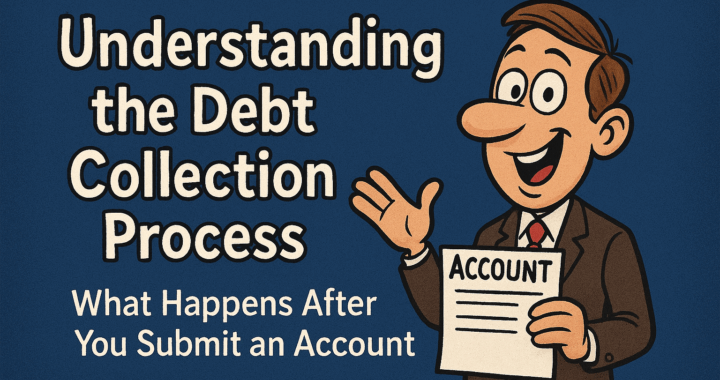For many businesses, unpaid invoices can feel like a constant obstacle—slowing cash flow, straining operations, and consuming valuable time. Submitting an account to a collection agency is an important step toward recovery, but what happens next?
Here’s a clear breakdown of the debt collection process so you know exactly what to expect when you place an account with a professional agency.
Step 1: Account Review and Onboarding
Once you submit an account, the collection agency reviews the documentation you provide—such as invoices, contracts, and statements—to confirm the debt is valid and legally collectible.
The agency then inputs the debtor’s information into their system, verifies contact details, and sets up the account for the next phase of collection activity.
What this means for you: Your claim is documented, organized, and ready for action.
Step 2: Initial Outreach to the Debtor
After onboarding, the agency reaches out to the debtor through approved channels—letters, calls, emails, or texts (when compliant).
The purpose of this first contact is to:
-
Notify the debtor that the account has been placed with collections.
-
Outline the balance due and available resolution options.
-
Provide legally required disclosures under regulations like the FDCPA.
What this means for you: Communication begins quickly, increasing the chance of early resolution.
Step 3: Negotiation and Resolution
In many cases, debtors respond to the initial outreach. Some are ready to pay in full, while others request a payment plan or raise questions about the balance.
The agency’s role is to:
-
Verify or validate the debt if needed.
-
Work with the debtor to establish a reasonable repayment plan.
-
Maintain professionalism while keeping recovery as the priority.
What this means for you: A skilled collector can secure payment while preserving relationships whenever possible.
Step 4: Monitoring and Follow-Up
If a debtor makes promises to pay but doesn’t follow through, the agency continues follow-up within legal and ethical boundaries. Consistent communication helps keep repayment on track.
What this means for you: The agency stays engaged so you don’t have to.
Step 5: Escalation When Necessary
Not all accounts resolve easily. If attempts to collect are unsuccessful, the account may move to escalation. Depending on your agreement, this may include:
-
Reporting the debt to credit bureaus.
-
Recommending legal action.
-
Closing the account if it’s deemed uncollectible.
What this means for you: You’re kept informed of all next steps, and escalation is handled strategically.
Step 6: Payment and Remittance
When payment is received, the agency processes it, deducts the agreed fee, and remits the balance to you. Regular reports keep you updated on recovery progress.
What this means for you: You receive your recovered funds quickly and transparently.
Final Thoughts
Submitting an account to collections isn’t about losing control—it’s about gaining a partner. A professional debt collection agency works as an extension of your team, dedicated to protecting your bottom line while maintaining compliance and professionalism.
By understanding each step of the process, you’ll know exactly what to expect, giving you confidence that your receivables are being managed with care and expertise.

